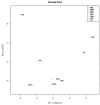Genotype-Dependent Response of Root Microbiota and Leaf Metabolism in Olive Seedlings Subjected to Drought Stress
- PMID: 38592857
- PMCID: PMC10974243
- DOI: 10.3390/plants13060857
Genotype-Dependent Response of Root Microbiota and Leaf Metabolism in Olive Seedlings Subjected to Drought Stress
Abstract
Under stress or in optimum conditions, plants foster a specific guild of symbiotic microbes to strengthen pivotal functions including metabolic regulation. Despite that the role of the plant genotype in microbial selection is well documented, the potential of this genotype-specific microbial assembly in maintaining the host homeostasis remains insufficiently investigated. In this study, we aimed to assess the specificity of the foliar metabolic response of contrasting olive genotypes to microbial inoculation with wet-adapted consortia of plant-growth-promoting rhizobacteria (PGPR), to see if previously inoculated plants with indigenous or exogenous microbes would display any change in their leaf metabolome once being subjected to drought stress. Two Tunisian elite varieties, Chetoui (drought-sensitive) and Chemleli (drought-tolerant), were tested under controlled and stressed conditions. Leaf samples were analyzed by gas chromatography-mass spectrometry (GC-TOFMS) to identify untargeted metabolites. Root and soil samples were used to extract microbial genomic DNA destined for bacterial community profiling using 16S rRNA amplicon sequencing. Respectively, the score plot analysis, cluster analysis, heat map, Venn diagrams, and Krona charts were applied to metabolic and microbial data. Results demonstrated dynamic changes in the leaf metabolome of the Chetoui variety in both stress and inoculation conditions. Under the optimum state, the PGPR consortia induced noteworthy alterations in metabolic patterns of the sensitive variety, aligning with the phytochemistry observed in drought-tolerant cultivars. These variations involved fatty acids, tocopherols, phenols, methoxyphenols, stilbenoids, triterpenes, and sugars. On the other hand, the Chemleli variety displaying comparable metabolic profiles appeared unaffected by stress and inoculation probably owing to its tolerance capacity. The distribution of microbial species among treatments was distinctly uneven. The tested seedlings followed variety-specific strategies in selecting beneficial soil bacteria to alleviate stress. A highly abundant species of the wet-adapted inoculum was detected only under optimum conditions for both cultivars, which makes the moisture history of the plant genotype a selective driver shaping microbial community and thereby a useful tool to predict microbial activity in large ecosystems.
Keywords: bulk soil; drought stress; indigenous and exogenous microbes; metabolomics; olive genotype; rhizosphere.
Conflict of interest statement
The authors declare no conflict of interest.
Figures






Similar articles
-
Erratum: High-Throughput Identification of Resistance to Pseudomonas syringae pv. Tomato in Tomato using Seedling Flood Assay.J Vis Exp. 2023 Oct 18;(200). doi: 10.3791/6576. J Vis Exp. 2023. PMID: 37851522
-
Comparative Physiological and Metabolic Analysis Reveals a Complex Mechanism Involved in Drought Tolerance in Chickpea (Cicer arietinum L.) Induced by PGPR and PGRs.Sci Rep. 2019 Feb 14;9(1):2097. doi: 10.1038/s41598-019-38702-8. Sci Rep. 2019. PMID: 30765803 Free PMC article.
-
Uncovering the dominant role of root metabolism in shaping rhizosphere metabolome under drought in tropical rainforest plants.Sci Total Environ. 2023 Nov 15;899:165689. doi: 10.1016/j.scitotenv.2023.165689. Epub 2023 Jul 20. Sci Total Environ. 2023. PMID: 37481084
-
Exopolysaccharides producing rhizobacteria and their role in plant growth and drought tolerance.J Basic Microbiol. 2018 Dec;58(12):1009-1022. doi: 10.1002/jobm.201800309. Epub 2018 Sep 5. J Basic Microbiol. 2018. PMID: 30183106 Review.
-
Plant survival under drought stress: Implications, adaptive responses, and integrated rhizosphere management strategy for stress mitigation.Microbiol Res. 2021 Jan;242:126626. doi: 10.1016/j.micres.2020.126626. Epub 2020 Oct 18. Microbiol Res. 2021. PMID: 33189069 Review.
Cited by
-
Microbial Allies or Adversaries? The Genotype-Dependent Impact of Inoculation on Silver Birch.Plants (Basel). 2025 Feb 10;14(4):545. doi: 10.3390/plants14040545. Plants (Basel). 2025. PMID: 40006804 Free PMC article.
-
Olive Tree Belowground Microbiota: Plant Growth-Promoting Bacteria and Fungi.Plants (Basel). 2024 Jul 5;13(13):1848. doi: 10.3390/plants13131848. Plants (Basel). 2024. PMID: 38999688 Free PMC article. Review.
-
Comparative metabolomics of leaves and stems of three Italian olive cultivars under drought stress.Front Plant Sci. 2024 Jul 3;15:1408731. doi: 10.3389/fpls.2024.1408731. eCollection 2024. Front Plant Sci. 2024. PMID: 39022609 Free PMC article.
-
Enhancing Abiotic Stress Resilience in Mediterranean Woody Perennial Fruit Crops: Genetic, Epigenetic, and Microbial Molecular Perspectives in the Face of Climate Change.Int J Mol Sci. 2025 Mar 29;26(7):3160. doi: 10.3390/ijms26073160. Int J Mol Sci. 2025. PMID: 40243927 Free PMC article. Review.
References
-
- Morgado R., Ribeiro P.F., Santos J.L., Rego F., Beja P., Moreira F. Drivers of irrigated olive grove expansion in Mediterranean landscapes and associated biodiversity impacts. Landsc. Urban Plan. 2022;225:104429. doi: 10.1016/j.landurbplan.2022.104429. - DOI
-
- Sofo A., Manfreda S., Fiorentino M., Dichio B., Xiloyannis C. The olive tree: A paradigm for drought tolerance in Mediterranean climates. Hydrol. Earth Syst. Sci. 2008;12:293–301. doi: 10.5194/hess-12-293-2008. - DOI
-
- Ozdemir Y. Effects of climate change on olive cultivation and table olive and olive oil quality. Sci. Pap. Ser. B Hortic. 2016;60:65–69.
-
- Tsiourtis N.X., Engineer S.W. Drought Management Plans for the Mediterranean Region. Report of the Water Engineer Water Development Department; European Commission; Nicosia, Cyprus: 2001.
LinkOut - more resources
Full Text Sources
Miscellaneous

